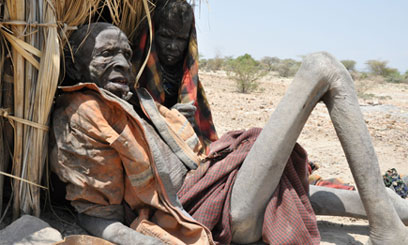TURKANA, Kenya, Sept 3 – Sitting outside a tiny manyatta in a village called Lomeliku in Kalapata location of Turkana County, we meet Kaler Uyereng, an elderly man probably in his 80s.
For the last two months, he has had nothing to eat or drink.
Kaler lives with his wife Achuka. Both are weak and hardly have the energy to walk and search for food.
“We have not received any food. It is now two months,” Achuka tells us as she covers her face as though in shame.
The couple has been left with no option but feed on wild fruits. The drought that has affected the area is so severe that even camels have lost their resilience. Carcasses can be spotted easily.
The story of hunger and thirst is not new to this region which is extremely hot and dry. It is also an area that has recently been at the centre of controversy after the area chief reported that some people had died of hunger.
However the government denied this saying they had no records of deaths as a result of hunger.
“The situation here is bad; people are suffering a lot because there is no food. There is also a lot of charcoal burning which has led to degradation of the environment,” says a local pastor Joseph Ekitui.
Although the Kenya Red Cross was in the area two weeks ago to take food under the Kenyans for Kenya initiative which has so far collected at least Sh688million for famine relief, the local pastor says some of the centres never received food despite the urgent need.
“When they bring food, it is taken to a centre that is about seven kilometres away. The ones suffering are the old because they can’t walk that distance and even if they send young children to get the food for them, sometimes they (children) come back empty handed,” he says.
He said that the Kenyans for Kenya initiative reached only two centres in the area, leaving out seven of them. The centre where Kaler and his wife Achuka could get their ration was not reached.
However the Kenya Red Cross Society (KRCS) says in the initiative, they targeted the most vulnerable population like children under five years, malnourished people, lactating and expectant mothers, elderly, the sick and school going children.
“We can’t reach everybody of course but we have reached a majority of our target group. The general food distribution is done by the government, we are there as an emergency,” KRCS Communications Manager Nelly Muluka says.
At Kalapata Primary School, the situation is different.
Although schools have closed, children come in as usual so as to benefit from the school feeding programme. The children come in as early as 6am to have breakfast and then attend remedial classes as they wait for lunch.
“The situation here is fair. We had supply of maize and beans from the World Food Programme (WFP); we had been supplied with unimix porridge by the Kenya Red Cross and the pupils are now feeding well,” the head teacher James Kibele says.
The school has a population of 485 pupils out of whom an average of 250 go to school everyday for the feeding programme.
“Since this school is the only one that is accommodating so many pastoralist children some stay 40 to 50 kilometres away and sometimes it becomes difficult for them to come from far because there is no provision of supper,” he adds.
The feeding programme is done Monday to Friday as per the WFP guidelines.
“Getting food here is helping because there is no food at home. If there was food at home, I could not come to school,” says Elson, a class eight pupil at the school.










































